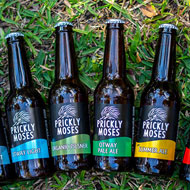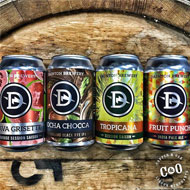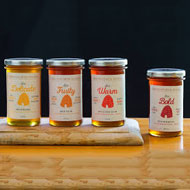 Rapid Labels featured in Australia – New Zealand Labels and Flexible Packaging Magazine March Edition
Rapid Labels featured in Australia – New Zealand Labels and Flexible Packaging Magazine March Edition
Hybrid trailblazer Rapid Labels’ Labelfire – “IT’S PERFECT!”
What kind of company purchases a completely new label press, never before installed in Australia – becoming the trailblazer? One with a strong belief in their own tradespeople and also huge faith in the machinery manufacturer. That company is Rapid Labels of Bayswater, Victoria and the press is the Gallus Labelfire 340 hybrid, now into its third year and performing “brilliantly.”
Rapid Labels’ Managing Director David Power takes up the story: “Initially, when we began looking at what press could best meet our need, we were very conscious of our plate cost when using our conventional flexo presses. We realised we needed a digital press for our short-run work, but we also require the capability to print conventional flexo for longer-run work.
“The Gallus Labelfire was the only machine which offered that capability back then, and also offered metallic ink capability, effectively allowing us to use silver ink and print the rest of the job digitally, thus delivering extra flexibility.”
Power says the company was already quite familiar with Gallus, as they had Gallus flexo machines. In total, Rapid had three different flexo presses on their floor in addition to an HP Indigo 6600. They felt the Labelfire 340 rounded-out their capability of having a press range to suit all kinds of work and run lengths.

He says what really convinced the company to invest in the Labelfire was being able to print digitally and finish in-line. “It offered a range of textured varnishes as well as cold foiling – all done in one pass. Being able to offer these kinds of services to clients is a major plus and a massive advantage in our marketplace,” he says. “When we put the Labelfire in, we also didn’t realise the high quality of ink lay-down compared with conventional presses, which is much higher and ideally suited to a product that requires a lot more light-resistance.
Being first is pioneering work
“This is the very process you need if you are printing products for outdoor use – you actually get a screen print look. And if you print onto clear materials you get the appearance that you have actually printed on the bottle, but you are doing it digitally, which is a massive advantage. The Labelfire offers a native (physical) resolution of 1200 x 1200 dpi with a droplet size of just 2pl and up to 200 grey scale values, corresponding to a visual resolution of 2400 x 2400 dpi. This physical resolution of the inkjet printheads offers a real advantage, particularly when it comes to small symbols and characters, as well as fine lines and gradients down to zero percent.
“When we started showing its wide applications to our clients, they realised very quickly what an effect they could achieve and, all of a sudden, we were creating a ‘first’. We ere the first printer to install Gallus Labelfire and when we purchased it, we didn’t realise it would open-up a whole new area of business. We had never even thought about that.”
Power says the Labelfire 340 is used in different markets and allows the company to sell high quality products that combine digital printing with silver ink from the flexo unit. “It took a while, but we now have the perfect mix of machinery which is great.”
Labels plus asked Dave Power about the suite of functions the press came with. “It’s unbelievable. The software is fantastic. It delivers an impressive number of practical functions including spot colour-matching. The PDF Toolbox and Prepress Manager are all suites that we use. You don’t get colour-shift. Whatever you program in, it’s waiting there the next time you print it. This is something we didn’t factor in. But you can scan it with a spectrometer and once you have the colour you desire, our guys save it on the press for the future.
“Even if our guys make an adjustment, the file is sitting is in the pre-press and the next time, the colour is exactly the same as the first-time print. It’s perfect!”
He says the ‘cool thing’ with inkjet is when you are jetting it on, there is no blanket – no variables. “The colour is the same time after time. I have never seen anything like it. In that sense it is better than flexo. No mixing and no variance – it’s a beautiful thing.”

Top-notch supplier support
Rapid Labels prints for a range of industries, including a lot of work pharmaceutical companies, boutique beers and wine, and cosmetic manufacturers. Power is highly-supportive of what the Labelfire press is now delivering but is the first to admit that when it was initially installed, they had the sort of problems that he puts down to using totally-new technology. “Gallus had their people fly out from Europe to assist but we did have problems and there were a lot of challenges in the beginning.
“However, when the Heidelberg team, led by Richard Timson came on board, it had a big impact. “Richard’s attitude was: ‘Let’s get this thing rolling.’ He was very helpful and spent a great deal of time getting the press to run as we had envisaged. But it was totally-new technology. Richard took a hands-on approach and we really started to sort out the problems we were facing. There were teething problems we hadn’t expected, but we did sort them out and now are really stoked with the results. The press runs so well.”
Factory Manager Ashton Devenish says the Labelfire 340 press has been: “… fantastic; it is a quality machine, producing quality labels. It is in the forefront of hybrid technology and, while we had early problems, Heidelberg came to the party. I think you have to understand that taking on a totally new kind of press with new technology is formidable. A lot of people are often scared of that kind of challenge.”
Another Rapid Labels member who is happy with the Labelfire, is operator Curtis Hill, who has been operating the Labelfire for the past three years, and really enjoys running the press. “It is completely new technology and you have to forget some of what you have already learnt – and learn a whole lot of new techniques. But it is a brilliant press. It was a steep learning curve as an operator, but once you understand it, it’s very user-friendly. The Labelfire gives us a lot of flexibility on the floor.”
Asked about the range of substrates that can be printed on, Curtis said the press was very versatile, was very ‘customisable’ and very easy to operate when you know how.



